Key takeaways
-
-
Early socialization is crucial: Expose your Rottie to many people, animals, and places while young.
-
Master basic obedience: Build a solid foundation with commands like "sit", "stay", "down", and "come".
-
Understand breed characteristics: Rottweilers are smart and protective, but can be stubborn, so tailor your training to their needs. Sources and related content
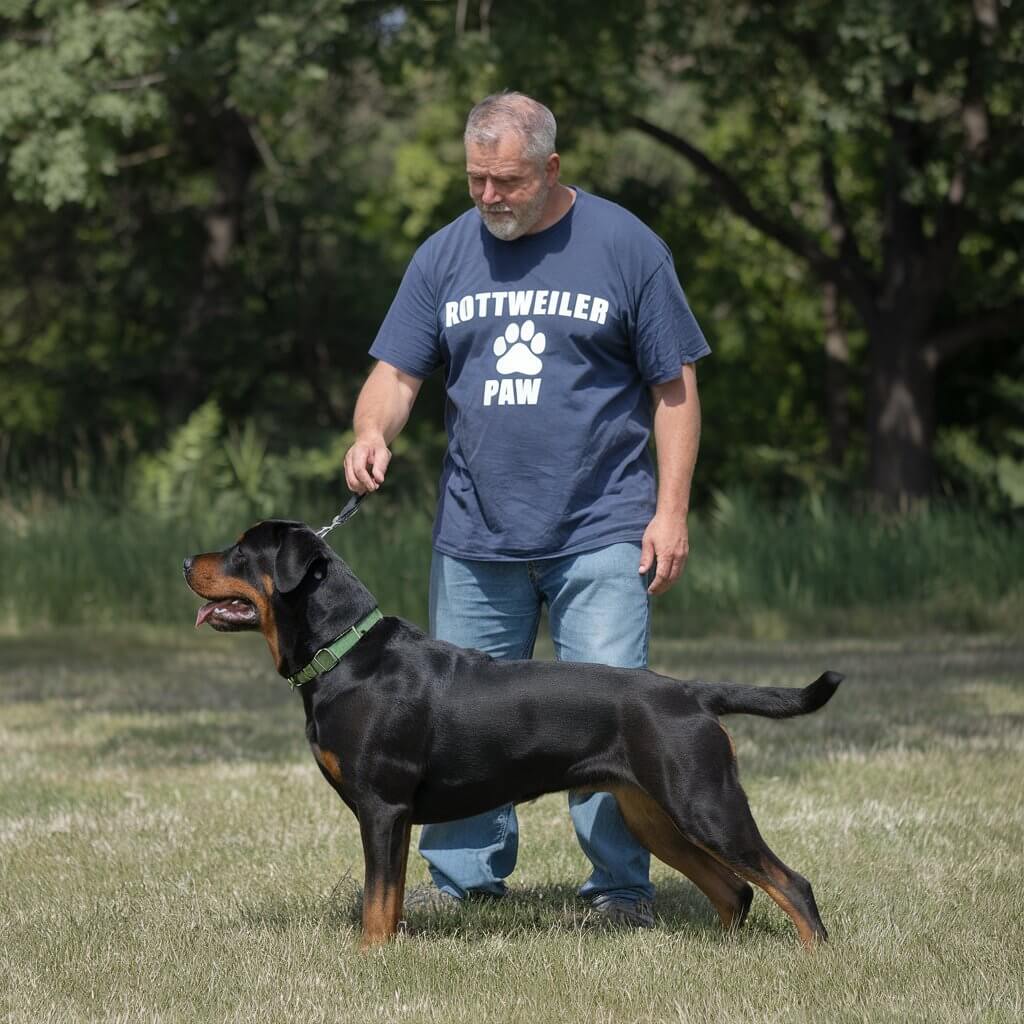
Rottweilers: these magnificent dogs boast a history as impressive as their muscular build. Descending from ancient Roman drovers, they’re renowned for their loyalty, strength, and protective instincts. But let’s be honest, sometimes those guarding instincts can go a little overboard (who knew the mailman could be so terrifying?!).
That’s where training comes in. It’s the key to unlocking your Rottweiler’s full potential and ensuring a happy, harmonious life together. Think of it as channeling their incredible energy and intelligence into positive behaviors.
Why is Rottweiler Training So Important?
Training plays a crucial role in curbing unwanted behaviors. Research indicates that dogs who undergo obedience training exhibit a significant reduction in behaviors like excessive barking, jumping, and destructive chewing. For example, a study by Herron et al. (2009) published in Applied Animal Behaviour Science found that dogs trained using positive reinforcement methods showed a marked decrease in problem behaviors.
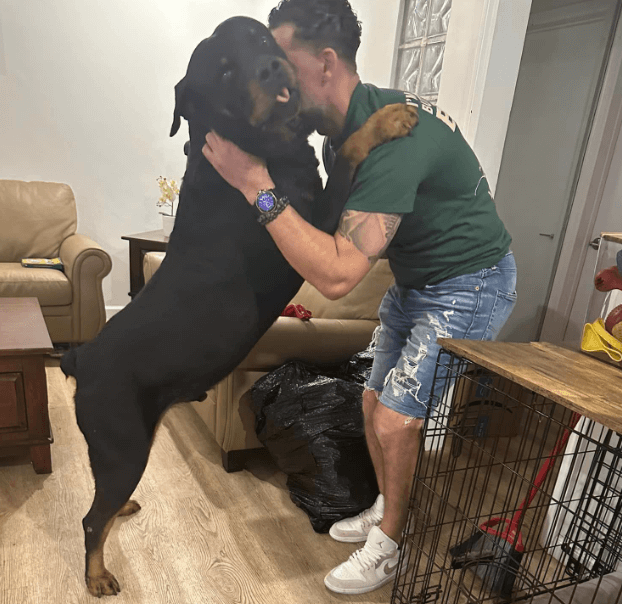
Training isn’t just about teaching commands; it’s about:
- Shaping a well-mannered companion: Say goodbye to jumping on guests or those “accidental” nips during playtime.
- Ensuring everyone’s safety: A well-trained Rottweiler is a predictable and safe Rottweiler, for both themselves and those around them.
- Building an unbreakable bond: Training strengthens your connection and creates a deep understanding between you and your Rottie.
The Training Adventure: From Puppyhood to Adulthood
Just like us, Rottweilers go through different life stages, and their training needs change right along with them.
Puppyhood (8-12 months): Think adorable fluffball with needle-sharp teeth! Focus on socialization, bite inhibition, and potty training.
Adolescence (1-2 years): The teenage years! Time to reinforce good habits and navigate those “testing the boundaries” moments with patience and consistency.
Adulthood (2+ years): Your Rottie is all grown up! Continue to refine their skills and enjoy the incredible bond you’ve built.
Ready to embark on this exciting journey? With the right approach and a sprinkle of patience, you’ll unlock your Rottweiler’s true potential and enjoy a lifetime of love, laughter, and those heartwarming Rottweiler snuggles.

Understanding Your Rottweiler
Rottweiler Temperament: A Unique Blend
They’re often painted as these big, tough guard dogs, and while that’s partly true (they are amazing protectors!), there’s a whole lot more to these incredible pups than meets the eye. Beneath that muscular exterior, you’ll find a loving, intelligent, and often goofy companion just waiting to burst out.

One of the first things you’ll notice about a Rottweiler is their unwavering loyalty. They’re like your shadow, following you from room to room, always up for a cuddle on the couch. But don’t mistake their affectionate nature for a lack of brains! Rottweilers are incredibly smart and eager to please, which makes them quick learners. Just keep in mind that all that brainpower needs an outlet. Think puzzle toys, interactive games, and a good dose of training to keep those minds engaged. A bored Rottweiler can quickly turn into a destructive Rottweiler, and nobody wants that!
Of course, we can’t talk about Rottweilers without mentioning their protective instincts. Bred to guard livestock and their families, they’re naturally wary of strangers or new situations. But with early socialization, you can help your Rottie distinguish between friend and foe (because, let’s be real, the mailman is not a threat!). Expose them to different people, places, and experiences from a young age, and they’ll grow into well-adjusted adults who know when to be watchful and when to relax.

Now, here’s the thing: Rottweilers can have a bit of a stubborn streak. They’re strong-willed and sometimes have a tendency towards dominance. But don’t worry, that doesn’t mean they’re untrainable! It just means you need to be a confident owner who sets clear boundaries and provides consistent leadership. Think of it like this: you’re the captain of the ship, and your Rottie needs to know you’re in charge. With the right guidance, they’ll learn to respect your authority and thrive on the structure you provide.
Ultimately, Rottweiler temperament is a beautiful mix of intelligence, loyalty, protectiveness, and a dash of that strong-willed spirit. By understanding these traits and providing proper training and socialization, you can unlock your Rottweiler’s true potential and enjoy a truly amazing bond. They’ll be your protector, your confidante, your cuddle buddy, and your partner in crime, all rolled into one furry package.
It’s important to note that while these behavioral problems can occur, the majority of Rottweilers do not exhibit them. The American Temperament Test Society (ATTS) reports that Rottweilers have a temperament passing rate of 84.8%, demonstrating that they are generally a stable and reliable breed. However, this further underscores the crucial role of training and socialization in nurturing their inherent temperament and preventing potential behavioral challenges.
Breed-Specific Considerations:
…Now, because we’re talking about Rottweilers here, there are a few breed-specific things to keep in mind. First off, these guys are serious athletes! We’re talking powerful muscles and boundless energy. That means daily walks are a must, and playtime is non-negotiable. A good game of fetch in the park? Always a winning idea. Remember, a tired Rottweiler is a happy Rottweiler (and a much less likely candidate for chewing on your favorite shoes!).
But it’s not just about physical exercise; those Rottweiler brains need a workout too! They thrive on mental challenges, so don’t forget to engage their minds. Puzzle toys are a great way to keep them entertained, and interactive games like hide-and-seek can really get those tails wagging. And of course, training sessions are a must. Not only will it reinforce good behavior, but it’ll also strengthen the bond between you and your furry friend..
Why Training Matters: More Than Just “Sit” and “Stay”
Training your Rottweiler isn’t just about obedience; it’s about building a strong foundation for a happy and fulfilling life together. It’s about creating a deep connection and understanding between you and your furry companion.
Think of it like this: training helps prevent those “oops” moments that can sometimes happen with a dog as strong and energetic as a Rottie. No more jumping on guests, chewing on furniture, or barking at every little sound. Training gives your Rottie the tools they need to navigate the human world and make good choices.
But here’s the real magic of training: it strengthens your bond like nothing else. It’s about communication, trust, and understanding. When you train your Rottweiler, you’re not just teaching them commands; you’re building a deep connection that will last a lifetime.
And let’s not forget, a well-trained Rottweiler is a confident and happy Rottweiler. They’re less likely to develop anxiety or aggression because they know what’s expected of them and feel secure in their role within your family.
By understanding your Rottweiler’s unique traits and needs, you’ll be well-equipped to start your training journey and create a lifelong bond with your amazing companion. So, embrace the journey, celebrate the small victories, and enjoy the incredible transformation that happens when you invest in training your Rottweiler. It’s a gift that keeps on giving, for both of you.
Training is not just about obedience; it significantly impacts a Rottweiler’s physical and mental well-being.
- Increased activity levels: Training often involves physical activities like walking, playing fetch, and practicing commands, which contribute to a dog’s overall fitness. A study by Christian et al. (2013) in the Journal of Animal Physiology and Animal Nutrition found that dogs involved in regular training activities had lower body fat percentages and increased muscle mass compared to sedentary dogs. .
- Reduced risk of obesity: Obesity is a common health issue in dogs, and Rottweilers are no exception. Engaging them in regular training can help maintain a healthy weight. The Association for Pet Obesity Prevention estimates that 56% of dogs in the US are overweight or obese. Training can combat this by promoting physical activity and mental stimulation, reducing the likelihood of overeating due to boredom.
- Improved mental health: Mental stimulation through training can alleviate boredom and frustration, which are common triggers for destructive behaviors in Rottweilers. A study by Zupan et al. (2014) in the Journal of Veterinary Behavior found that dogs who received regular training exhibited fewer anxiety-related behaviors and were generally more relaxed and confident.
Basic Obedience Training Building a Foundation for Success
Okay, so you’re ready to dive into training your Rottweiler! Awesome! But where do you even begin? Don’t worry, we’ve got you covered. Basic obedience training is the foundation for a well-behaved and happy Rottie. It’s like teaching them the ABCs of being a good dog (and trust me, those puppy-dog eyes will be extra effective when they know how to “sit” on command!).
According to the American Kennel Club (AKC), consistent training with positive reinforcement can result in a success rate of 70-80% in teaching dogs basic obedience commands like “sit,” “stay,” “come,” and “down.”
Foundation Commands: The Must-Knows
Let’s dive right into those essential foundation commands that every well-mannered Rottie should know. Think of these as the building blocks for a happy, harmonious life together.
- Sit: This classic command is a great starting point. It teaches your Rottie to focus and control their impulses (which comes in handy when those squirrels are putting on a show in the park!).
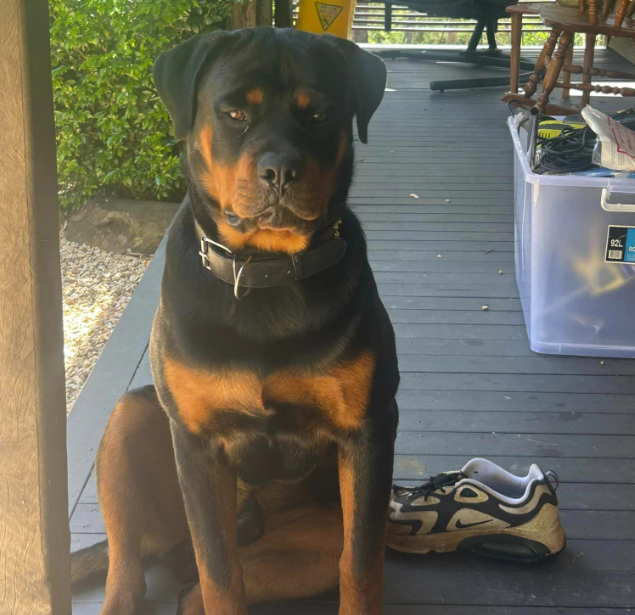
- Stay: Ah, the “stay” command – the key to preventing those daring escapes out the front door and keeping your Rottie safe in all sorts of situations.
- Come: This one’s a lifesaver! Teaching your Rottie to come when called is essential for safety and those off-leash adventures (because who doesn’t love a good romp in the park where they can really stretch their legs?).
- Down: The “down” command encourages relaxation and helps your Rottie settle down when things get a bit too exciting (like when guests arrive or those tempting treats are sitting on the counter!).
- Leave it: This is all about impulse control. Teaching your Rottie to “leave it” can prevent them from chewing on your favorite shoes or snatching that accidentally dropped food (no matter how delicious it smells!).
- Off: Whether it’s jumping on guests with excitement or getting a little too enthusiastic during playtime, “off” helps your Rottie understand boundaries and respect personal space.
- Mastering these foundational commands will set you and your Rottweiler up for success. But remember, training is an ongoing journey, not a destination. So, let’s explore some tips and tricks to make the process fun and rewarding for both of you…
Positive Reinforcement: The Key to Happy Learning
Now, let’s talk about the secret sauce of successful Rottweiler training: positive reinforcement. It’s like magic, but instead of pulling a rabbit out of a hat, you’re bringing out the best in your furry friend. The idea is simple: reward those good behaviors and create a positive learning experience that makes your Rottie eager to learn more.
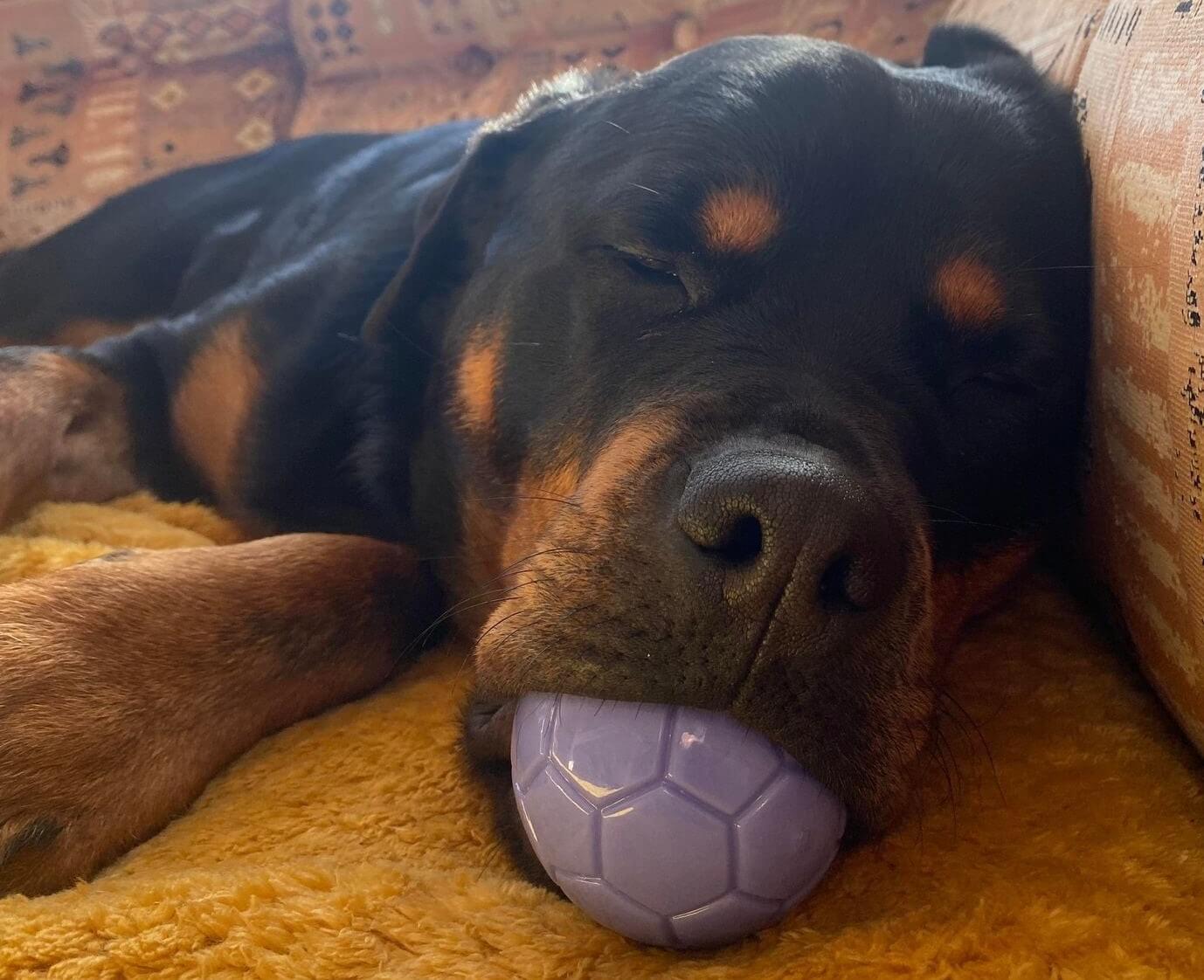
Studies like the one by Blackwell et al. (2008) published in the Journal of Veterinary Behavior show that positive reinforcement methods, which emphasize rewarding desired behaviors, are highly effective. This approach fosters a positive learning environment, making the process enjoyable for both the dog and the owner.
- Treats, Praise, and Playtime: Oh My!
Every dog is different, so find what motivates your Rottie! Is it a tasty treat that gets their tail wagging? Maybe it’s enthusiastic praise and a good head scratch. Or perhaps a fun game of tug-of-war is their ultimate reward. Whatever it is, use it to celebrate those successful moments during training.
- Timing is Everything
Here’s a pro tip: timing is key when it comes to positive reinforcement. Make sure you reward your Rottie immediately after they perform the desired behavior. This helps them connect the dots and learn faster. Think of it like this: if you waited a whole minute to give them a treat after they sat down, they might think they’re being rewarded for something else entirely, like scratching their ear or sniffing the ground.
By using positive reinforcement consistently, you’ll create a fun and rewarding training experience for both you and your Rottie. They’ll learn faster, be more eager to please, and most importantly, build a strong bond of trust with you. But hold on, there’s more to discover on this training adventure…
- Consistency and Patience: Your Training Superpowers
Rottweilers thrive on consistency. Use clear and concise commands every time, and be patient as they learn. Remember, they’re not trying to be difficult; they’re just figuring things out (and sometimes those squirrels are really distracting!).
Training Tools: Gear Up for Success
Every superhero needs their trusty gadgets, right? Well, in the world of dog training, those gadgets come in the form of training tools. They can make a world of difference in helping you and your Rottweiler succeed.
- Collars, Leashes, and Harnesses: The Training Trio
First things first, a well-fitting collar and leash are your training essentials. They’re not just for walks; they’re also crucial for those training sessions where you’re teaching your Rottie to heel or walk politely by your side. And if your Rottie is a bit of a puller (especially during those energetic puppy phases!), consider using a harness. It distributes pressure more evenly and prevents choking, making walks more comfortable for both of you.
- Clickers: Your Training Sidekick
Now, if you want to take your training to the next level, consider adding a clicker to your arsenal. Clicker training is a fantastic way to mark desired behaviors with precision and provide instant feedback to your Rottie. The sound of the clicker becomes a clear signal that they’ve done something right, making learning faster and more efficient.
With these basic obedience commands, the power of positive reinforcement, a sprinkle of patience, and those trusty training tools, you’ll be well on your way to creating a well-mannered and happy Rottweiler. So, grab those treats, put on your training hat, and get ready to unleash your Rottie’s full potential! But hold on, there’s even more to explore on this exciting journey…
Advanced Rottweiler Training: Level Up Your Rottie's Skills (and Impress Your Friends!)
Congratulations! You’ve mastered the basics with your Rottweiler. Ready to go beyond “sit” and “stay”? Advanced training challenges your Rottweiler’s mind, strengthens your bond, and unlocks a whole new level of skills and possibilities. Think of it as earning your black belt in dog training (and your Rottie getting an extra-special treat for being such a smarty-pants!).
Building on the Basics: Real-World Challenges
- Proofing Commands: Taking it to the Streets (and Parks, and Beaches…)
Sure, your Rottie might “sit” like a pro in the comfort of your living room, but what about at the park with all those tempting smells and playful pups running around? That’s where proofing comes in. It’s like taking your training on the road and making sure those commands stick, no matter the location or level of distraction.
Start gradually. Maybe practice “stay” in your backyard first, then at a quiet park, and eventually in busier places with more hustle and bustle. This helps your Rottie generalize their training and learn to listen to you even when the world is throwing a party around them.
- Distraction Training: Focus in the Chaos
Speaking of distractions, let’s talk about distraction training. It’s like training your Rottie to have laser focus, even when things get exciting. Gradually introduce distractions during your training sessions. Maybe have a friend walk by, or play some dog park sounds in the background. The key is to start small and gradually increase the intensity of the distractions.
This helps your Rottie build resilience and maintain control even when their senses are going wild. Think of it like this: you’re teaching them to be the calm in the storm, the focused one amidst the chaos. And that’s a superpower worth having!
With these real-world challenges conquered, you and your Rottweiler will be an unstoppable team, ready to take on any adventure that comes your way. But hold on tight, because we’re about to dive into the exciting world of off-leash freedom…
Off-Leash Adventures: Freedom with Control
Ah, the dream of off-leash adventures! Imagine your Rottweiler running free, exploring the world with boundless energy and a wagging tail. It’s a beautiful picture, right? But before you unleash your inner adventurer, let’s talk about how to make those off-leash experiences safe and enjoyable for both of you.
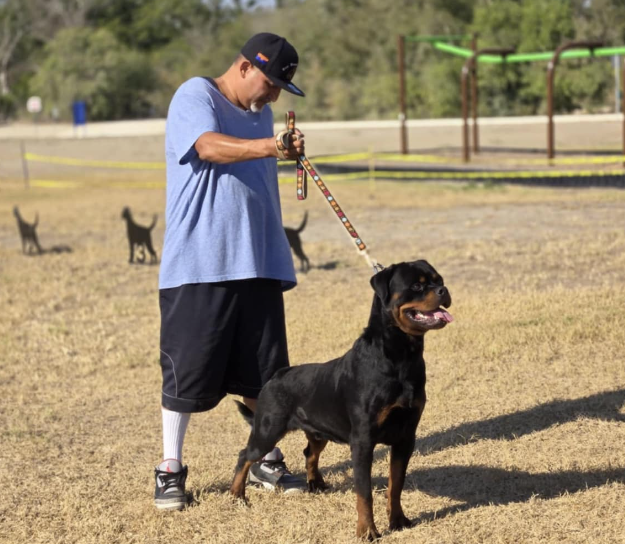
- Reliable Recall: The Off-Leash Foundation
Off-leash training starts with a rock-solid “come” command. This is non-negotiable, my friend. You need to know that when you call your Rottie, they’ll come running back to you, no matter how tempting those squirrels or how interesting that scent trail might be.
Start practicing in a safe, enclosed area like your backyard or a fenced-in dog park. Use a long leash at first, gradually giving them more freedom as they become more reliable with their recall. And remember, positive reinforcement is your best friend here. Make coming back to you the most exciting thing ever with praise, treats, or a fun game of tug-of-war.
- Impulse Control: Mastering the Art of Self-Control
Off-leash freedom doesn’t mean your Rottie has free rein to chase every squirrel or greet every dog they see. Impulse control is key. Teach your Rottie to resist those tempting distractions and maintain focus even when off-leash.
This takes practice, but it’s absolutely achievable. Start with short off-leash sessions in controlled environments and gradually increase the difficulty. Reward them for ignoring distractions and staying by your side. With time and consistency, they’ll learn to control their impulses and make good choices even when off-leash.
With reliable recall and a good dose of impulse control, you and your Rottweiler will be ready to embark on those off-leash adventures with confidence. Just imagine the joy of watching them run free, explore the world, and come back to you with a happy grin and wagging tail. It’s a beautiful thing! But hold on, there’s even more to discover on this training journey…
Advanced Commands: Showing Off Those Smarts
Now that your Rottweiler has aced those foundation commands, it’s time to unleash their inner genius and teach them some advanced skills. Get ready to be amazed by how much they can learn!
- Heel: Picture this: you and your Rottie strolling through the park, them walking politely by your side without even needing a leash. That’s the power of the “heel” command. It’s perfect for those leisurely walks where you want to show off your well-mannered companion (and avoid any accidental tripping!).
- Fetch and Drop It: This classic game is a winner for a reason. It’s not only fun for your Rottie, but it’s also mentally stimulating and a great way to burn off some of that endless energy. Plus, there’s nothing quite like seeing that joyful expression when they bring that ball back to you.
- Speak and Quiet: Teaching your Rottie to “speak” on command (and then “quiet” down) can be incredibly helpful for those doorbell situations or when things get a bit too noisy. It gives you a way to control their barking and maintain a peaceful environment.
These advanced commands not only add to your Rottie’s skillset but also strengthen your bond and provide them with a sense of accomplishment. But don’t stop there! Let’s add some fun and flair with trick training…
Trick Training: Unleashing the Fun
Who says training has to be all serious business? It’s time to inject some fun and laughter into your sessions with trick training! Not only is it a blast for both of you, but it also boosts your Rottie’s confidence and strengthens your bond.
- Roll Over, Play Dead, Shake Paws: These classic tricks are always a crowd-pleaser. Imagine your Rottie rolling over on command or playing dead with dramatic flair. It’s not just entertaining; it also helps them learn body awareness and coordination.
- Creativity is Key: Don’t be afraid to think outside the box with your trick training! Teach your Rottie to fetch specific toys by name, close doors, or even tidy up their toys (okay, maybe that last one is a bit ambitious, but hey, a dog can dream!). The more creative you get, the more fun you’ll both have.
- The Rewards of Advanced Training
Advanced training is all about building on those foundational skills and creating a well-rounded, responsive, and happy Rottweiler. It’s about challenging your Rottie, celebrating their successes, and enjoying the incredible journey of training together.
So, get ready to unleash your Rottie’s inner showman (or show-dog!), have a blast with trick training, and revel in the joy of watching them grow into a confident, capable companion. But hold on, we’re not done yet! There’s one more crucial aspect of Rottweiler training we need to discuss…
Socialization and Behavioral Issues: Raising a Well-Adjusted Rottie
Socialization is key to raising a happy and well-adjusted Rottweiler. Think of it as introducing your Rottie to the world and helping them become confident and friendly in various situations (because nobody wants a dog that barks at every leaf that blows by!). According to the American Veterinary Society of Animal Behavior, early and effective socialization is crucial for preventing behavioral problems in Rottweilers
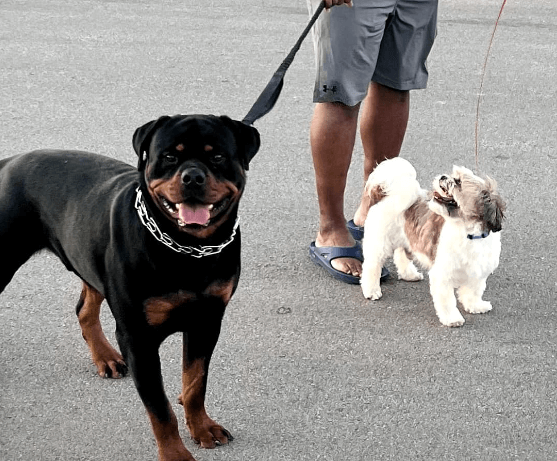
Importance of Early Socialization
Those early puppy months are a critical period for socialization. It’s when your Rottie is forming their impressions of the world, so it’s important to make those experiences positive and enriching.
- Puppy Parties and Playdates: Expose your Rottie puppy to different people, dogs, and environments. Think puppy classes, visits to friends’ houses, and walks in the park. These early interactions help them learn how to interact appropriately with others and build confidence in social situations.
- Positive Experiences: Make sure those early experiences are positive! This helps your Rottie build confidence and associate new things with good times (rather than fear or anxiety). Keep those first encounters short, sweet, and fun, and always be there to provide support and reassurance.
- Variety is Key: Expose your Rottie to different sights, sounds, and smells. Take them for walks in different neighborhoods, introduce them to people of different ages and appearances, and let them experience a variety of sounds, from the vacuum cleaner to the doorbell. The more they experience early on, the more adaptable and well-adjusted they’ll become.
Socialization isn’t a one-time event; it’s an ongoing process. Continue to expose your Rottie to new experiences throughout their life, and they’ll reward you with a confident, friendly demeanor and a zest for life. But hold on, there’s one more important aspect of Rottweiler training we need to cover…
Preventing Behavioral Problems:
- Aggression: Rottweilers can be protective by nature, so it’s crucial to address any signs of aggression early on. This includes things like growling, snapping, or lunging. Training and socialization play a huge role in preventing aggression, as they help your Rottie learn appropriate social skills and build confidence. Understanding their body language is also key, so you can recognize subtle signs of discomfort or stress before they escalate.
Research indicates that aggression in Rottweilers is often directed towards unfamiliar dogs rather than humans. A study by Duffy et al. (2008) published in Applied Animal Behaviour Science found that Rottweilers exhibited higher rates of aggression towards unfamiliar dogs compared to some other breeds. This highlights the importance of early socialization and consistent training to ensure they develop appropriate social skills with other dogs.
- Anxiety:Separation anxiety or fear-related behaviors can sometimes pop up in Rottweilers. They’re a sensitive breed, and changes in their routine or environment can sometimes trigger anxiety. Providing a safe and comfortable environment for your Rottie, along with plenty of exercise and mental stimulation, can help prevent anxiety. If you notice signs of anxiety, don’t hesitate to seek professional help from a certified dog trainer or veterinary behaviorist. If you’re facing challenges with training your Rottweiler, the Association of Professional Dog Trainers can help you find a qualified and certified dog trainer in your area.
Separation anxiety can be a concern in Rottweilers, as they are a breed that often forms strong bonds with their families. The American Rottweiler Club estimates that approximately 15% of Rottweilers may experience some form of separation anxiety.
- Destructive Behaviors: Chewing, digging, or excessive barking can be signs of boredom or frustration in Rottweilers. Remember those powerful jaws and boundless energy? They need an outlet! Make sure your Rottie gets plenty of exercise and mental stimulation to keep them happy and content. Puzzle toys, interactive games, and training sessions are your best friends here.
- By being mindful of these potential behavioral issues and taking proactive steps to prevent them, you can ensure that your Rottweiler thrives in their environment and enjoys a happy, well-adjusted life. And remember, if you encounter any challenges along the way, don’t hesitate to seek guidance from a qualified professional. They can provide tailored support and help you navigate any bumps in the road.
Remember:
When it comes to raising a happy and well-adjusted Rottweiler, socialization and prevention are your greatest allies. By investing time and effort in these areas, you’re not just preventing potential problems; you’re setting your Rottie up for a lifetime of confidence, happiness, and joyful companionship.
- Early Intervention is Key
Addressing potential behavioral issues early on is much easier than trying to fix them later. So, be mindful of your Rottie’s behavior, and don’t hesitate to seek help if you notice any red flags. Early intervention can make a world of difference.
- Professional Help is a Click Away
Don’t hesitate to seek help from a certified dog trainer or behaviorist if you’re facing challenges. They can provide expert guidance and support, tailored to your Rottie’s specific needs. Think of them as your training mentors, there to help you navigate any bumps in the road.
- The Rewards of a Well-Socialized Rottie
By focusing on socialization and addressing potential behavioral issues proactively, you’ll help your Rottweiler grow into a confident, well-adjusted, and happy companion who enjoys exploring the world with you! Imagine the joy of watching your Rottie confidently greet new people, play politely with other dogs, and navigate different environments with ease. It’s a testament to your dedication and love, and a reward in itself.
Rottweiler Puppy Training: Starting Off on the Right Paw
Congratulations on bringing your adorable Rottweiler puppy home! Get ready for a whirlwind of puppy breath, playful antics, and maybe a few chewed shoes along the way. But don’t worry, with the right approach to training, you’ll set your Rottie up for success and create a lifelong bond.
“The early months of a Rottweiler puppy’s life are critical for their development. Research by Scott and Fuller (1965) in their book “Genetics and the Social Behavior of the Dog” highlights the importance of early socialization during the ‘critical period’ (between 3 and 14 weeks of age). Puppies exposed to positive social experiences during this time are more likely to develop into well-adjusted adults.
For instance, “Zara,” a Rottweiler puppy who began training and socialization classes at 8 weeks old, quickly learned basic commands and developed excellent social skills with both dogs and humans. Her early training foundation contributed to her becoming a well-mannered and confident adult dog, excelling in obedience competitions and enjoying a happy life with her family.
Special Considerations for Puppies: Navigating Those Early Days
- Housebreaking: Patience is Your Best Friend
Potty training a Rottweiler puppy requires patience, consistency, and a whole lot of cleaning supplies (just kidding… mostly!). Establish a routine, take your puppy outside frequently, and reward those outdoor potty breaks like they just won an Olympic gold medal. And don’t get discouraged by occasional accidents. It happens to the best of us (puppies and humans alike!). Just remember to clean those messes thoroughly to prevent lingering smells and future accidents in the same spot.
- Bite Inhibition: Teaching Those Sharp Teeth to Be Gentle
Those puppy teeth are sharp! But don’t worry, you can teach your Rottie to be gentle with their mouth during play. When those little nips get too intense, redirect their attention to a toy and praise them for soft mouths. You can also use a high-pitched “ouch” to let them know they’ve been a bit too rough. With consistent training, they’ll learn to inhibit their bite and play nicely.
- Early Socialization: Building a Confident Pup
Socialization is crucial for Rottweiler puppies. It’s like giving them a head start in life, helping them become confident and well-adjusted in various situations. Expose them to a variety of people, dogs, and environments to prevent fear-based behaviors later on. Think puppy classes, playdates with friendly dogs, and walks in the park. The more positive experiences they have early on, the more confident and adaptable they’ll become.
With these puppy-specific considerations in mind, you’ll be well-equipped to navigate those early days and set your Rottweiler up for a lifetime of happiness and success. So, embrace the puppy chaos, cherish those adorable moments, and enjoy the incredible journey of raising your Rottie from a playful pup to a confident companion.
Remember: Puppy Training Essentials
- Positive Reinforcement:Always use positive methods like treats, praise, and toys to motivate your puppy and create a positive learning experience. Puppies thrive on encouragement and positive feedback, so make those training sessions fun and rewarding. The ASPCA emphasizes the effectiveness of positive reinforcement for training dogs, highlighting its benefits in building a strong bond and encouraging desired behaviors
- Short and Sweet: Keep those training sessions short and engaging to match your puppy’s attention span. Remember, puppies have a limited attention span, so keep those sessions short, sweet, and focused. A few minutes of focused training is much more effective than a long, drawn-out session that leaves your puppy bored and frustrated.
- Consistency is Key: Establish clear rules and boundaries from the start, and stick to them consistently. This helps your puppy understand expectations and learn faster. Consistency is key in all aspects of puppy training, from potty training to basic commands. The more consistent you are, the faster your puppy will learn and the stronger your bond will become.
Cherishing the Puppy Days
Puppyhood is a crucial time for learning and development. By focusing on housebreaking, bite inhibition, and socialization, you’ll lay the foundation for a well-mannered and happy adult Rottweiler. So, embrace those puppy snuggles, celebrate those training milestones, and enjoy this special time with your new furry friend! It goes by fast, so cherish every moment.
Now that we’ve covered the puppy essentials, let’s move on to some more specific training scenarios and address some common challenges that Rottweiler owners might encounter…VII. Training for First-Time Rottweiler Owners: You’ve Got This! (But a Little Help Never Hurts)
Training for First-Time Rottweiler Owners: You've Got This!
Bringing a Rottweiler into your life is a big decision! These powerful and loyal dogs can bring so much joy, but they also come with unique training needs. If you’re a first-time Rottie owner, here are a few tips to set you up for success:
Tips for New Owners
- Realistic Expectations: Rottweilers are intelligent, but they’re not mind-readers. Be patient and understanding during the training process. Celebrate those small victories and remember that consistency is key. Rome wasn’t built in a day, and neither is a perfectly trained Rottie!
- Bonding is Key: Building a strong bond with your Rottie is the foundation of training. Spend quality time together, play games, go for walks, and shower them with affection (those cuddles are irresistible!). The stronger your bond, the more receptive they’ll be to your guidance.
- Start Early: Begin training as soon as you bring your Rottie home. Early socialization and basic obedience training are crucial for preventing behavioral issues later on. Those early months are a critical period for learning and development, so make the most of them!
- Seek Professional Help: Don’t hesitate to reach out to a certified dog trainer or behaviorist if you’re facing challenges. They can provide expert guidance and support tailored to your Rottie’s specific needs. Think of them as your training partners, there to help you navigate any obstacles.
- Embrace the Journey: Training a Rottweiler is an ongoing process, but it’s incredibly rewarding. Enjoy the journey, celebrate those milestones, and cherish the incredible bond you’re building with your amazing companion. The memories you create will last a lifetime.
With love, patience, and consistent training, your Rottweiler will blossom into a confident, well-mannered companion who brings joy and love to your life for many years to come. So, go out there and create some amazing memories together!
Remember:
- Positive Reinforcement: Use positive training methods like treats, praise, and toys to motivate your Rottie and create a positive learning experience. They’ll respond much better to encouragement and rewards than to harsh corrections.
- Consistency is Key: Establish clear rules and boundaries from the start, and stick to them consistently. This helps your Rottie understand expectations and learn faster. Consistency provides them with a sense of security and predictability.
- Love and Patience: Rottweilers thrive on love and affection. Be patient, understanding, and consistent with your training, and you’ll be amazed by the incredible bond you create with your Rottie. They’ll return your love tenfold with their unwavering loyalty and devotion.
Bringing a Rottweiler into your home is an adventure filled with love, loyalty, and maybe a few slobbery kisses along the way. Embrace the journey, be patient with your Rottie, and don’t hesitate to seek help when needed. You’ve got this! With dedication and love, you’ll create a lifelong bond with your amazing Rottie companion.
Product Recommendations: Gear Up for Rottweiler Success
Every Rottweiler deserves the best! From puppyhood to adulthood, having the right supplies can make all the difference in their training, comfort, and overall well-being. So, let’s dive into some essential gear for your awesome Rottie:
Essential Supplies: Gearing Up Your Rottie
- Food and Bowls: Fueling Those Adventures
Choose high-quality food that meets your Rottie’s age and activity level. Think of it as providing them with the premium fuel they need to power those playful romps and training sessions. And don’t forget sturdy food and water bowls (because those big paws can sometimes be a bit clumsy!). Stainless steel or ceramic bowls are a good choice, as they’re durable and easy to clean.
A crate provides a safe haven for your Rottie, a place where they can relax and feel secure. It’s also a valuable tool for potty training, as it helps them develop bladder control and prevents accidents in the house. And let’s be honest, a crate can be a lifesaver when those puppy teeth are in overdrive and your furniture is looking tempting. Just make sure the crate is large enough for your Rottie to stand up, turn around, and lie down comfortably.
- Collars and Leashes: Exploring the World Safely
A well-fitting collar and a sturdy leash are essential for walks and training sessions. They provide you with control and ensure your Rottie’s safety when you’re out and about. Consider a harness for extra control, especially during those energetic puppy phases when they might be prone to pulling.
- Toys: Unleashing the Fun
Rottweilers love to play! Choose durable toys that can withstand those powerful jaws. Interactive toys and puzzle feeders can provide mental stimulation and prevent boredom. Think Kongs filled with treats, chew toys that challenge their minds, and toys that encourage interactive play, like tug ropes or frisbees.
- Training Tools: Aiding Your Journey
Clickers, training treats, and even a long line for off-leash practice can be helpful tools in your training journey. A clicker helps you mark desired behaviors with precision, while training treats provide positive reinforcement. A long line gives your Rottie some freedom to explore while still maintaining control during off-leash training sessions.
By providing your Rottweiler with these essential supplies, you’re setting them up for a comfortable, happy, and fulfilling life. So, go ahead and spoil your Rottie with some awesome gear! They deserve it.
Remember:
- Quality Matters: Invest in high-quality products that are safe and durable. Your Rottie will thank you (with lots of slobbery kisses!). Cheap toys or flimsy beds might not hold up to those powerful jaws and playful antics.
- Tailored to Your Rottie: Choose products that fit your Rottie’s size, age, and activity level. A puppy will have different needs than an adult Rottie, so choose accordingly.
- Safety First: Always supervise your Rottie with new toys or chews to ensure they’re safe and appropriate. And be sure to inspect toys regularly for any signs of wear and tear.
With these essential supplies and a mindful approach, you’ll be well-equipped to provide your Rottweiler with a comfortable, safe, and enriching environment. So, go ahead and spoil your Rottie a little – they deserve it! After all, they’re not just pets; they’re cherished members of your family.
Are Rottweilers Good with Kids?
Many potential Rottweiler owners ask this crucial question. The short answer is yes – Rottweilers can be excellent family companions when properly trained and socialized. Their natural protective instincts, combined with their remarkable intelligence and gentle nature, make them potentially outstanding guardians for children. However, success depends heavily on proper training, early socialization, and responsible ownership.
For an in-depth look at this topic, read our comprehensive analysis: Are Rottweilers Good with Kids? 5 Essential Truths From a Veterinarian’s Experience. Dr. Charlie Steedman, with over 15 years of clinical experience, shares evidence-based insights and real-world success stories that will help you make an informed decision about bringing a Rottweiler into your family.
Your Rottweiler Training Journey – A Lifelong Adventure!
Wow, what a journey it’s been! We’ve explored the ins and outs of Rottweiler training, from those adorable puppy days to the sometimes-challenging teenage phase, all the way to advanced commands and beyond.
Remember, training your Rottweiler isn’t just about teaching them to sit and stay; it’s about building an unbreakable bond, creating a safe and happy environment, and helping your Rottie thrive in every aspect of their life.
Keep Those Brains Busy!
Rottweilers are intelligent and energetic dogs who need both physical and mental stimulation. Keep those tails wagging and those minds engaged with ongoing learning and playtime. Think puzzle toys that challenge their problem-solving skills, interactive games that keep them entertained, and maybe even a dog sport or two to channel their energy and enthusiasm. A mentally stimulated Rottie is a happy and well-behaved Rottie.
Celebrate the Victories!
Training takes time and patience, but the rewards are immeasurable. Celebrate those training milestones, no matter how small. Cherish those goofy Rottie moments that make you laugh, and embrace the incredible journey of training your amazing companion. After all, a well-trained Rottweiler is a happy Rottweiler, and a happy Rottweiler makes for a happy human!
So, go out there and continue this incredible adventure with your Rottie. Explore new places, learn new skills, and create a lifetime of memories together. With love, dedication, and a sprinkle of fun, your Rottweiler will be your loyal companion, your confidante, and your furry best friend for many years to come.
FAQs
1. When should I start training my Rottweiler?
Training should ideally begin as early as 8 weeks old. Focus on basic commands and socialization during puppyhood.
2. Are Rottweilers easy to train?
Rottweilers are intelligent and eager to please, which generally makes them receptive to training. However, they can be strong-willed, so consistency and positive reinforcement are crucial.
3. What are the most important commands to teach my Rottweiler?
Core commands include: sit, stay, come, down, leave it, and heel. These commands provide a foundation for good behavior and control.
4. How do I address common Rottweiler behavior issues like nipping or chewing?
Redirect unwanted behaviors with appropriate chew toys and provide plenty of mental and physical exercise. Consider crate training to manage destructive tendencies.
5. Do Rottweilers require specialized training?
While not mandatory, enrolling your Rottweiler in obedience classes or working with a professional trainer can be beneficial, especially for first-time owners. This provides structured learning and addresses specific needs.


![You are currently viewing Rottweiler Training: The Complete Guide [Expert Tips & Techniques]](https://rottweilerpaw.com/wp-content/uploads/2024/10/Blue-Success-Guide-Tips-YouTube-Thumbnails.png)


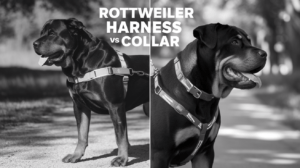


Pingback: 5 Simple Steps to Crate Train Rottweiler Puppy (and Why You Should!)
Pingback: Rottweiler Advanced Training: Level Up Your Rottie's Skills
Pingback: German Shepherd Rottweiler Mix: Is This Loyal Breed Right for You?
Pingback: American Rottweiler vs German Rottweiler: Busting the Breed Myths!